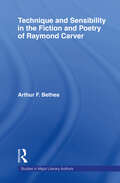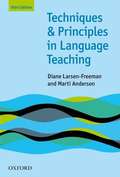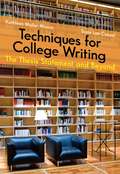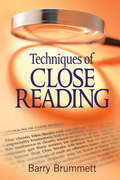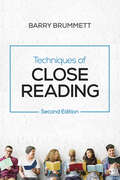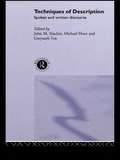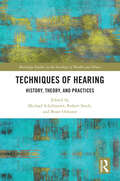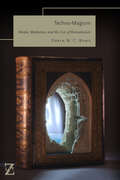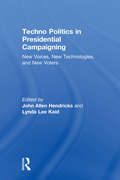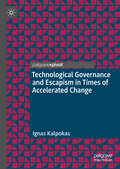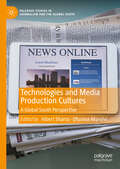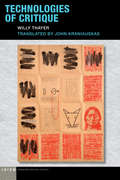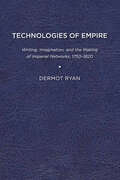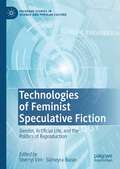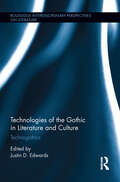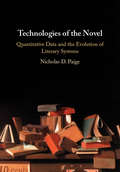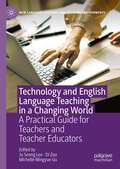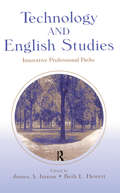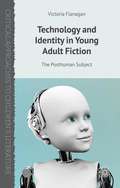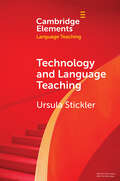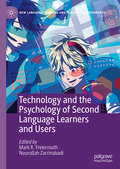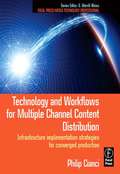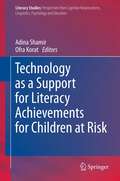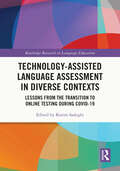- Table View
- List View
Technique and Sensibility in the Fiction and Poetry of Raymond Carver (Studies in Major Literary Authors #7)
by Arthur F. BetheaA comprehensive examination of the fiction and poetry of Raymond Carver.
Techniques and Principles in Language Teaching
by Diane Larsen-Freeman Marti AndersonTechniques and Principles in Language Teaching helps you to learn about many different language teaching methods, to uncover the thoughts that guide your own actions as a teacher, and introduces you to a variety of techniques. The third edition includes chapters on: The Grammar-Translation Method The Direct Method The Audio-Lingual Method The Silent Way DesuggestopediaCommunity Language Learning Total Physical Response Communicative Language Teaching Content-based Instruction Task-based Language Teaching The Political Dimensions of Language Teaching and the Participatory Approach Learning Strategy Training,Cooperative Learning, and Multiple Intelligences Emerging Uses of Technology in Language Teaching and Learning View Diane Larsen-Freeman explaining the need to consider a range of methods in language teaching, and how methods continue to evolve. View Marti Anderson explaining the importance of reflecting on methodology. Links to videos on website
Techniques for College Writing: The Thesis Statement and Beyond
by Kathleen Muller Moore Susie Lan CasselThis book is divided into three parts that build on one another. Part One (Thinking Through the Thesis Statement) introduces the basics for writing a paper--from think¬ing about the audience and format to developing a thesis statement and concluding well. Part Two (Thinking Through Your Writing Assignment) moves to the next stage of the writing process by looking more closely at the writing prompt and its requirements to plan a response that is relevant and appropriate. Part Three (Writing Beyond the Composition Classroom) looks beyond the composition classroom to more specialized writing, such as writing for a scientific paper, an informa¬tive paper, and literature reviews.
Techniques of Close Reading
by Barry S. BrummettIn a world in which messages increasingly ask us to believe, accept, buy, and follow, the ability to read texts closely in order to gain a deeper understanding of their meanings is an indispensable survival skill. Techniques of Close Reading is a brief book that helps students see what texts may be saying, be they written, oral, visual, or mediated. Renowned scholar and professor Barry Brummett explains and explores the various ways to "read" messages (such as speeches, cartoons, or magazine ads), teaching students how to see deeper levels of meaning and to share those insights with others. Students learn techniques for discovering form, rhetorical tropes, argument, and ideologies within texts.This book differs from other books in rhetorical criticism, textual analysis, or critical thinking by: Focusing on the act and techniques of criticism rather than on schools of thought, grand theories, and specific methods, thus helping students to engage in the act of critical close reading in ways that are congenial to a wide range of methods - making the book an ideal companion to texts focused on specific methodsExplaining the relationships among theory, methods, and techniques of rhetorical criticismExamining the ethics and risks of doing and reading rhetorical criticism via plenty of examples, figures, and exercises taken from everyday life Serving as a brief, affordable text, thus allowing instructors the flexibility to assign other textbooks
Techniques of Close Reading
by Barry S. BrummettTechniques of Close Reading, Second Edition helps you gain a deeper understanding of what texts may be saying, whether they are written, oral, visual, or mediated. Renowned scholar and professor Barry Brummett explains and explores the various ways to "read" messages (such as speeches, cartoons, or magazine ads), teaching you how to see deeper levels of meaning and to share those insights with others. You will learn techniques for discovering form, rhetorical tropes, argument, and ideologies within texts. New to the Second Edition: A new Chapter 6 includes a selection of techniques from each chapter to show you how different techniques may be used together when reading text. A close reading of a group of ads from the insurance company, Liberty Mutual, offers you an opportunity to apply the techniques to recent texts.
Techniques of Close Reading
by Barry S. BrummettTechniques of Close Reading, Second Edition helps you gain a deeper understanding of what texts may be saying, whether they are written, oral, visual, or mediated. Renowned scholar and professor Barry Brummett explains and explores the various ways to "read" messages (such as speeches, cartoons, or magazine ads), teaching you how to see deeper levels of meaning and to share those insights with others. You will learn techniques for discovering form, rhetorical tropes, argument, and ideologies within texts. New to the Second Edition: A new Chapter 6 includes a selection of techniques from each chapter to show you how different techniques may be used together when reading text. A close reading of a group of ads from the insurance company, Liberty Mutual, offers you an opportunity to apply the techniques to recent texts.
Techniques of Description: Spoken and Written Discourse
by Gwyneth Fox Michael Hoey John M. SinclairThis book is a tribute to Malcolm Coulthard, who has been remarkably active and influential across a wide range of English Language Studies. He is particularly well-known for his pioneering work in spoken and written discourse analysis and most recently, for his work in forensic linguistics. This collection of specially commissioned, state-of-the-art pieces by leading international linguists is dedicated to the man and his achievements and provides a showcase for the most exciting developments in applied discourse studies. All the papers share common assumptions about language study: that descriptions should be data-based, data-tested and replicable. The collection as a whole contains original and important new research on descriptions, with intriuging applications to forensic, gender and literary studies.
Techniques of Hearing: History, Theory and Practices
by Michael Schillmeier, Robert Stock, and Beate OchsnerHearing, health and technologies are entangled in multi-faceted ways. The edited volume addresses this complex relationship by arguing that modern hearing was and is increasingly linked to and mediated by technological innovations. By providing a set of original interdisciplinary investigations that sheds new light on the history, theory and practices of hearing techniques, it is able to explore the heterogeneous entanglements of sound, hearing practices, technologies and health issues. As the first book to bring together historians, scholars from media studies, social sciences, cultural studies, acoustics and neuroscientists, the volume discusses modern technologies and their decisive impact on how ‘normal’ hearing, enhanced and smart hearing as well as hearing impairment have been configured. It brings both new insights into the histories of hearing technologies as well as allowing us to better understand how enabling hearing technologies have currently been unfolding an increasingly hybrid ecology engaging smart hearing devices and offering stress-free hearing and acoustic wellbeing in novel auditory environments. The volume will be of interest to all scholars and students of disability studies, sound studies, sociology of health and illness, medical history, health and society as well as those interested in the practices and techniques of self-monitored and smart hearing.
Techno-Magism: Media, Mediation, and the Cut of Romanticism (Lit Z)
by Orrin N. WangShortlisted, Marilyn Gaull Book AwardTechno-Magism explores how British Romantic literature abuts and is organized around both print and non-print media. The book explores not only the print, pictorial art, and theater of early nineteenth-century England and Europe but also communicative technologies invented after the British Romantic period, such as photography, film, video, and digital screens. This proleptic abutting points to one way we can understand the implicit exceptionality wagered by reading Romanticism through media studies and media theory.Techno-Magism argues that both media studies and the concept of mediation in general can benefit from a more robust confrontation with, or recovery of, the arguments of deconstruction, an unavoidable consequence of thinking about the relationship between Romanticism and media. The book thinks that relationship through the catachrestic practice of a techno-magism, a technics of inscription always outside the causalities of a dialectical economy. The book further pursues two interrelated ideas: the structural incommensurability of the cut and the unapologetic presentism of the constellation. Marked by its late capitalist moment of composition, the book explores the continuity between the social character of Romantic and post-Romantic media, in terms of commodity culture, revolution, and the ecological devastation of the anthropocene.
Techno Politics in Presidential Campaigning: New Voices, New Technologies, and New Voters
by John Allen Hendricks Lynda Lee KaidThe 2008 US presidential campaign saw politicians utilizing all types of new media -- Facebook, MySpace, YouTube, Twitter, e-mail, and cell phone texting – to reach voters of all ages, ethnicities, socio-economic backgrounds, and sexual orientations. This volume examines the use of these media and considers the effectiveness of reaching voters through these channels. It explores not only the use of new media and technologies but also the role these tactics played in attracting new voters and communicating with the electorate during the 2008 presidential debates. Chapters focus on how the technologies were used by candidates, the press, and voters.
Technological Governance and Escapism in Times of Accelerated Change (Information Technology and Global Governance)
by Ignas KalpokasThis book examines escapist coping strategies brought about by the pace, breadth and governance of technological change. It argues that escapism manifests in various forms, ranging from nostalgia for a fantasised past of unhindered reason and agency, to progressive visions of societal and political improvement, and greater empowerment. Drawing on post-humanist theory and critical disability studies, the book also assesses how escapism should not be viewed as an unavoidable reaction to technological change, and develops a model for an ethically equitable relationship between humans and technology. It will appeal to all those interested in governance and politics, media and communication studies, technology studies, and philosophy.
Technologies and Media Production Cultures: A Global South Perspective (Palgrave Studies in Journalism and the Global South)
by Ufuoma Akpojivi Albert SharraThis volume delves into the intricate relationship between technology and media production, emphasizing its influence across political, socio-economic, and cultural contexts. By 2010, the integration of computing and automated systems had already begun revolutionizing media production, prompting traditional outlets to embrace a 'digital first' approach. Concepts like dual-management processes and the fusion of traditional and digital systems have emerged, challenging conventional norms. What sets this transformation apart is the gradual replacement of human decision-making with communicative artificial intelligence and automation. Technology now plays a central role in producing and distributing news and Ads, fundamentally altering the media landscape. However, there has been limited exploration of the broader implications of these advancements, particularly from the perspective of the Global South. This edited volume seeks to address this gap by featuring papers that examine how technology has reshaped newsroom and advertorial processes in countries like Malawi, South Africa, and Nigeria. Through a collection of insightful essays, readers are invited to explore the transformative power of technology in media production, packaging, and distribution systems. From digital innovations to traditional media adaptations, this volume offers a comprehensive understanding of the evolving media landscape in the age of technology.
Technologies of Critique (Idiom: Inventing Writing Theory)
by Willy ThayerCritique—a program of thought as well as a disposition toward the world—is a crucial resource for politics and thought today, yet it is again and again instrumentalized by institutional frames and captured by market logics. Technologies of Critique elaborates a critical practice that eludes such capture. Building on Chile’s history of dissident artists and the central entangling of politics and aesthetics, Thayer engages continental philosophical traditions, from Aristotle, Descartes and Heidegger through Walter Benjamin and Gilles Deleuze, and in implicit conversation with the Judith Butler, Roberto Esposito, and Bruno Latour, to help pinpoint the technologies and media through which art intervenes critically in socio-political life.
Technologies of Empire: Writing, Imagination, and the Making of Imperial Networks, 1750–1820
by Dermot RyanTechnologies of Empire looks at the ways in which writers of the long eighteenth century treat writing and imagination as technologies that can produce rather than merely portray empire. Authors ranging from Adam Smith to William Wordsworth consider writing not as part of a larger logic of orientalism that represents non-European subjects and spaces in fixed ways, but as a dynamic technology that organizes these subjects and transforms these spaces. Technologies of Empire reads the imagination as an instrument that works in tandem with writing, expanding and consolidating the networks of empire. Through readings across a variety of genres, ranging from Smith’s The Wealth of Nations and Edmund Burke’s Reflections on the Revolution in France to Maria Edgeworth’s Irish fiction and Wordsworth’s epic poetry, this study offers a new account of writing’s role in empire-building and uncovers a genealogy of the romantic imagination that is shot through by the imperatives of imperialism. Published by University of Delaware Press. Distributed worldwide by Rutgers University Press.
Technologies of Feminist Speculative Fiction: Gender, Artificial Life, and the Politics of Reproduction (Palgrave Studies in Science and Popular Culture)
by Sherryl Vint Sümeyra BuranTechnologies of Feminist Speculative Fiction: Gender, Artificial Life, and the Politics of Reproduction explores how much technology has reshaped feminist conversations in the decades since Donna Haraway’s influential “Cyborg Manifesto” was published. With sections exploring reproductive technologies, new ways of imagining femininity and motherhood via artificial means, queer readings of gender as a social technology, and posthuman visions of a world beyond gender, this book demonstrates how feminist speculative fiction offers an urgently needed response to the intersections of women’s bodies and technology. This collection brings together authors from Europe, Japan, the US and the UK to consider speculative films and texts, reproductive technologies and food futures, and opportunities to rethink family, aging, gender and sexuality, and community through feminist speculative fiction, a social technology for building better futures.
Technologies of the Gothic in Literature and Culture: Technogothics (Routledge Interdisciplinary Perspectives on Literature)
by Justin D. EdwardsThis volume, a collection with contributions from some of the major scholars of the Gothic in literature and culture, reflects on how recent Gothic studies have foregrounded a plethora of technologies associated with Gothic literary and cultural production. The engaging essays look into the links between technologies and the proliferation of the Gothic seen in an excess of Gothic texts and tropes: Frankensteinesque experiments, the manufacture of synthetic (true?) blood, Moreauesque hybrids, the power of the Borg, Dr Jekyll’s chemical experimentations, the machinery of Steampunk, or the corporeal modifications of Edward Scissorhands. Further, they explore how techno-science has contributed to the proliferation of the Gothic: Gothic in social media, digital technologies, the on-line gaming and virtual Goth/ic communities, the special effects of Gothic-horror cinema. Contributors address how Gothic technologies have, in a general sense, produced and perpetuated ideologies and influenced the politics of cultural practice, asking significant questions: How has the technology of the Gothic contributed to the writing of self and other? How have Gothic technologies been gendered, sexualized, encrypted, coded or de-coded? How has the Gothic manifested itself in new technologies across diverse geographical locations? This volume explores how Gothic technologies textualize identities and construct communities within a complex network of power relations in local, national, transnational, and global contexts. It will be of interest to scholars of the literary Gothic, extending beyond to include fascinating interventions into the areas of cultural studies, popular culture, science fiction, film, and TV.
Technologies of the Novel: Quantitative Data and the Evolution of Literary Systems
by Nicholas D. PaigeBased on a systematic sampling of nearly 2000 French and English novels from 1601 to 1830, this book's foremost aim is to ask precisely how the novel evolved. Instead of simply 'rising', as scholars have been saying for some sixty years, the novel is in fact a system in constant flux, made up of artifacts – formally distinct novel types – that themselves rise, only to inevitably fall. Nicholas D. Paige argues that these artifacts are technologies, each with traceable origins, each needing time for adoption (at the expense of already developed technologies) and also for abandonment. Like technological waves in more physical domains, the rises and falls of novelistic technologies don't happen automatically: writers invent and adopt literary artifacts for many diverse reasons. However, looking not at individual works but at the novel as a patterned system provides a startlingly persuasive new way of understanding the history and evolution of artforms.
Technology and English Language Teaching in a Changing World: A Practical Guide for Teachers and Teacher Educators (New Language Learning and Teaching Environments)
by Ju Seong Lee Di Zou Michelle Mingyue GuThis edited book explores the integration of technology into English language education, with a particular focus on extracurricular and extramural contexts. The editors and an international team of scholars discuss how English teachers can critically and systematically design and implement language activities inside and outside the classroom to improve students’ receptive and productive skills. The book also discusses how teachers can harness technology to enhance their teaching practices. The combination of theory, digital materials, teaching activities, evidence-based reflections, and a focus on Extracurricular and Extramural contexts will make this book an invaluable resource for pre-service and in-service language teachers on ESL, EFL, and TESOL courses, as well as researchers in Applied Linguistics.Chapter 12 is available open access under a Creative Commons Attribution 4.0 International License via link.springer.com.
Technology and English Studies: Innovative Professional Paths
by James A. Inman Beth L. HewettIn scholarship about technology and English studies, there are a number of first-person narratives that suggest what may be termed "traditional" professional paths. That is, they chronicle the positive influence of a particular technology, class, professor, or publication, and suggest that it inspired a distinct and rewarding professional path. What is missing is the rest of the story--alternate ways that individuals have come to do work in technology and English studies and analysis of what this means for paths others might pursue. Technology and English Studies: Innovative Professional Paths meets this need.The volume begins with definitions of its three central terms: technology, English Studies, and professional paths. Chapters are organized in four sections, reflecting both a chronological progression and thematic professional development: "The Past as the Future"; "Searching the Academy"; "Pushing Boundaries"; and "Forging Beyond." As a forerunner in addressing professionalization across the domains that comprise technology and English studies, it will prove foundational for many readers with non-traditional or otherwise alternate backgrounds who are working out what professional paths might be available to them.Technology and English Studies: Innovative Professional Paths is an important professional development resource for professors, instructors, and graduate students across the field of English studies, including rhetoric and composition, computers and writing, computer-assisted language learning, literary and linguistic computing, literary studies, English education, technical communication, linguistics, writing centers, second-language education/ESL, and creative writing.
Technology and Identity in Young Adult Fiction
by Victoria FlanaganTechnology and Identity in Young Adult Fiction is not a historical study or a survey of narrative plots, but takes a more conceptual approach that engages with the central ideas of posthumanism: the fragmented nature of posthuman identity, the concept of agency as distributed and collective and the role of embodiment in understandings of selfhood.
Technology and Language Teaching (Elements in Language Teaching)
by Ursula SticklerThis Element is a practical guide for language teachers intending to upgrade their online teaching. During the COVID-19 pandemic many teachers were forced to move their teaching online without proper preparation and support. This has led to frustration and stress, and sometimes decisions based not on sound pedagogy but on technological constraints, requirements and opportunities. To balance this negative experience, a research-based, pedagogy-focussed approach has been taken in this volume: step-by-step, teachers are shown how to make decisions about the choice and usage of online tools, how to adapt their pedagogy and teaching strategies to fit with online learning environments, and how to create a positive learning experience for their students. In six sections this Element takes teachers from epistemological considerations to learning theories, from teacher-centred to learner-centred online tuition, and from technological needs to pedagogic choice, ending with suggestions on how to future-proof language teaching.
Technology and the Psychology of Second Language Learners and Users (New Language Learning and Teaching Environments)
by Nourollah Zarrinabadi Mark R. FreiermuthThis edited volume brings together large-scale research as well as case studies from a range of geographical contexts and represents a variety of educational settings involving second language learners and users. Its aim is to explore the interrelated issues of psychology and technology use in second language learning settings as well as in more autonomous environments. As language learning professionals continue to devote more time and attention to making various technological tools an integral part of the classroom, it is just as important to understand the influences that these tools have on the psychological state of the learners who use them. In consideration of this objective, the volume examines factors such as learner attitudes and motivation, emotion and behaviour, and the cognitive processes that are at play in the minds of the language users. This volume will be of interest not only to language teachers but also to researchers working in second language acquisition (SLA), applied linguistics, and educational psychology.
Technology and Workflows for Multiple Channel Content Distribution: Infrastructure implementation strategies for converged production
by Philip J. CianciThis book addresses the emergence of multi-channel broadcasting. Televisions, PC's, handheld and mobile reception devices now all receive content hat was once solely distributed by broadcast TV.No book currently on the market addresses the production infrastructure necessary to efficiently produce content for multi-channel delivery to a variety of reception platforms/devices.Readers will acquire an overview of not just the technology, but processes that impact the creative process and new cross-platform advertising sale/buy model.
Technology as a Support for Literacy Achievements for Children at Risk
by Ofra Korat Adina ShamirPresenting cutting-edge studies from various countries into the theoretical and practical issues surrounding the literacy acquisition of at-risk children, this volume focuses specifically on the utility of technology in supporting and advancing literacy among the relevant populations. These include a range of at-risk groups such as those with learning disabilities, low socioeconomic status, and minority ethnicity. Arguing that literacy is a key requirement for integration into any modern society, the book outlines new ways in which educators and researchers can overcome the difficulties faced by children in these at-risk groups. It also reflects the rapid development of technology in this field, which in turn necessitates the accumulation of fresh research evidence.
Technology-Assisted Language Assessment in Diverse Contexts: Lessons from the Transition to Online Testing during COVID-19 (Routledge Research in Language Education)
by Karim SadeghiThis timely collection explores the role of digital technology in language education and assessment during the COVID-19 pandemic. It recognises the unique pressures which the COVID-19 pandemic placed on assessment in language education, and examines the forced shift in assessment strategies to go online, the existing shortfalls, as well as unique affordances of technology-assisted L2 assessment. By showcasing international examples of successful digital and computer-assisted proficiency and skills testing, the volume addresses theoretical and practical concerns relating to test validity, reliability, ethics, and student experience in a range of testing contexts. Particular attention is given to identifying lessons and implications for future research and practice, and the challenges of implementing unplanned computer-assisted language assessment during a crisis. Insightfully unpacking the ‘lessons learned’ from COVID and its impact on the acceleration of the shift towards online course and assessment delivery, it offers important guidelines for navigating assessment in different instructional settings in times of crisis. It will appeal to scholars, researchers, educators, and faculty with interests in educational measurement, digital education and technology, and language assessment and testing.
